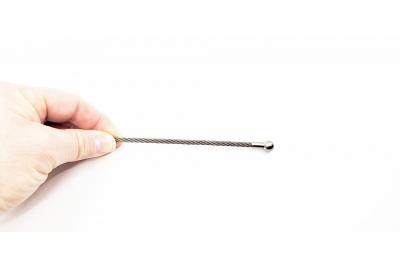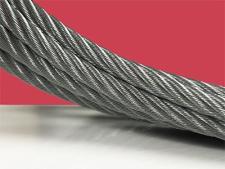There is no one-size-fits-all material when producing mechanical cable. The right material for your wire rope depends entirely on your application requirements. Consider Tungsten cable or Wolfram cable (W, atomic number 74) for instance. Tungsten is an earth metal. Tungsten wire is commonly used in the manufacturing of light bulb filaments, X-ray tubes and arc-welding electrodes. Tungsten's melting point is the highest melting temperature of all metals known to man and can be complex to work with.
But if the application requires high temperatures and tensile strength, tungsten wire rope becomes ideal. By comparison, 316 stainless steel melts at between 2,500 °F – 2,550 °F and does not outlast tungsten’s lifespan. Tungsten doesn’t melt until it reaches 6,192 °F, making this unique alloy 2.5 times more tolerant to extreme temperatures. And tungsten outlasts all other cable material in terms of pure cycles over time too.
Tungsten for High-Temperature Applications
Carl Stahl Sava Industries has worked with several companies that grow silicon ingots for the semiconductor and solar industries. In this particular application, technicians attach a small piece of silicon, called a boule, to a pure tungsten-made, mechanical cable assembly. The boule is dipped in pure molten silicon and is slowly pulled up in a crystal growing furnace. This process can take as long as 24 hours, yielding a piece of silicon between 12 and 18 inches in diameter and up to six feet long. This hardened crystal is subsequently sliced into wafers and polished to form flat substrates used for manufacturing semiconductors. Sava is one of the few mechanical cable manufacturers that produce these sophisticated tungsten cable assemblies.
Sava has also worked with the manufacturers of the furnaces used in these complex, silicon-making applications. Stainless steel, contrary to tungsten, quickly anneals at 1,900 °F. A stainless steel cable rated for 2,400 pounds would be derated to 1,200 pounds after only a short time exposed to these extreme temperatures within the furnace.
Tungsten on the other hand, due to it’s high melting temperature, is not sensitive to the high temperatures within the furnace and will retain its original cable strength.
There are tradeoffs to consider when choosing which cable material to use in such applications however. In this case, Sava knew that less expensive stainless steel cable would not rise to the task due to the extreme temperatures involved in the silicon ingot manufacturing process. Therefore, tungsten made the most sense for the project. While rare and expensive, tungsten distinguishes itself with its thermal properties and actually also increases its capacity to tolerate more cycles and thus have a longer lifespan.
While one could use stainless steel cable in the silicon growing application, the cable would have to be replaced far more frequently, making the initial savings represented in using stainless steel only momentarily beneficial. Tungsten cable, though a considerably more expensive material to work with, extends cycles and reduces maintenance, downtime and replacement costs tenfold.
Tungsten for High-Tech Medical Applications & Surgical Robots
But mechanical cable manufacturers don't just choose tungsten cable because it can take the heat. It’s also chosen when lives are at stake. As medical products and surgical instruments continue to shrink in size, tungsten cables have become an essential component in the new generation medical device market.
One can find small diameter tungsten mechanical cables inside various surgical robots. Surgical robots allow doctors to perform complex surgical procedures through a robotic console outside of the operating room. This revolutionary innovation in robotic surgery is used in the execution of procedures like prostatectomies, cardiac valve repair and certain gynecological surgeries.
While one factor in building surgical robots is cost, using tungsten to actuate movement in these fascinating devices becomes rather intuitive. With human beings under a knife wielded by a machine, the machine has to work. A malfunction could cause surgical complications or accidents, threatening the safety of the patient. Tungsten assures reliability over time and behaves imperviously to surgical conditions as well.
Tungsten: Reliable, Strong, and Resistant
In the cable industry, Tungsten is used in stranding various cable constructions. Anything from the more common 1x7, 7x7, 7x19 constructions to more complex constructions such as 7x37, 19x19 and 19x37. These more complex constructions provide excellent tensile strength, high modulus and superior flexibility for more demanding applications found in todays surgical instrumentation. The constructions allow these extreme durability cables to handle high loads and severe bending requirements over small pulleys.
To make these constructions in the finished cable diameters necessary, it is necessary to use wire as small as .0005” diameter.
Tungsten has the highest tensile strength of any metal as well. It also resists abrasion over a long period of time - as a matter of fact, longer than almost any other material. Understanding even only these fundamental tungsten benefits makes it simple to see why tungsten is trusted by device makers and doctors who use such devices as surgical robots.
Related Content:
Tungsten Cable For Surgical Robotics
Cutting Tungsten Mechanical Cable
Tungsten Wire: The Perfect Fit For Surgical Robotics
Is Tungsten Right for Your Operation?
While Tungsten is expensive and challenging and expensive, the strength and durability of tungsten cable weigh heavily in its favor with respect to the cost/benefit ratio. Contact Sava today to discuss your tungsten mechanical cable assembly needs today.






